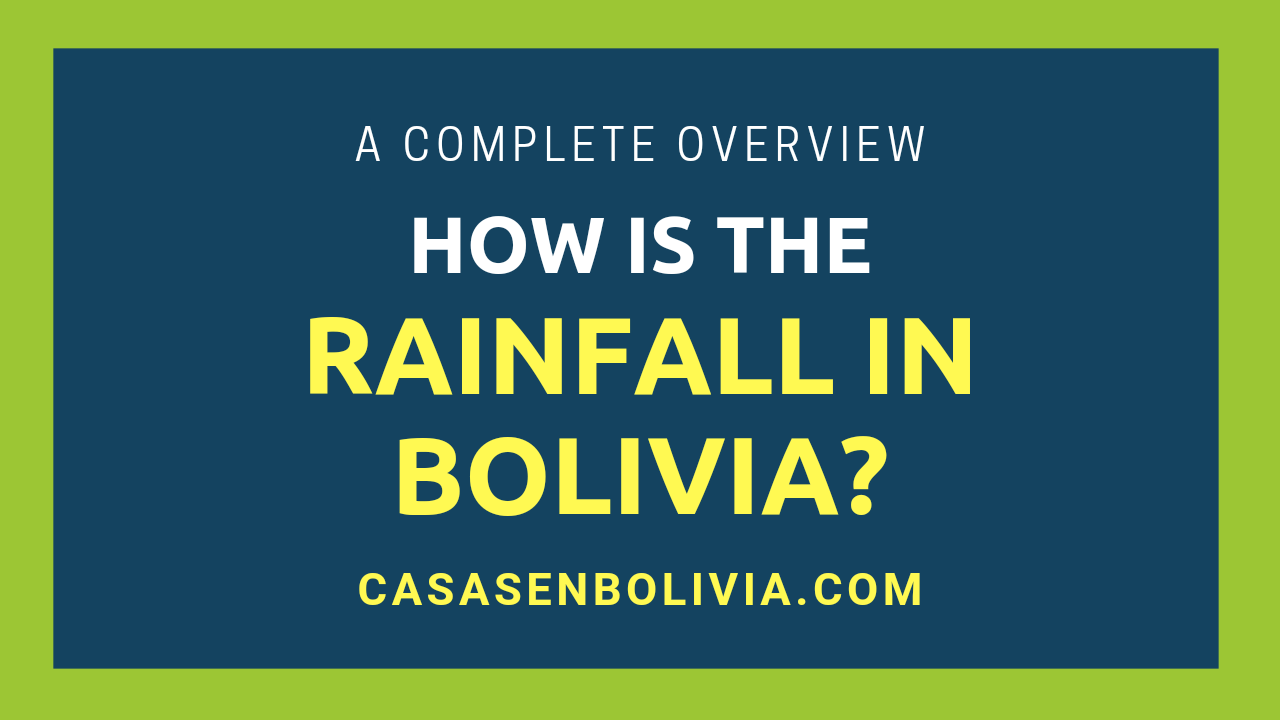Last Updated on February 15, 2025
In Bolivia, rainfall varies significantly across the country’s six distinct climates. The western, central, and southern regions experience minimal rainfall throughout the year, with almost none during the mid-year months. Conversely, the northern and eastern regions receive substantial rainfall, which intensifies from December to February.
Average annual rainfall in Bolivia is as follows: La Paz, El Alto, Oruro, and Potosí cities average 491mm; Cochabamba, Sucre, and Tarija cities average 558mm; Santa Cruz and Trinidad cities average 1,698mm; and Cobija city averages 1,895mm. Mid-year rainfall ranges from 27mm to 365mm, while year-end rainfall ranges from 400mm to 1,540mm.
In this comprehensive guide to rainfall in Bolivia, you’ll learn all the details about precipitation patterns, including when and where it’s most and least prevalent across the country. We’ll discuss how rainfall varies across Bolivia’s different climatic regions, the average rainfall in our country and its major cities, and other relevant details. We are Bolivian real estate experts (see our Bolivian real estate website).
Average Rainfall in Bolivia: A General Overview
In Bolivia, you’ll observe two primary seasons in terms of rainfall:
- The wet season (spanning September to March, nationwide).
- The dry season (spanning April to August, nationwide).
The difference in average rainfall between these two seasons can have a ratio ranging from 1/5 to 1/10. This means that *rainfall during the wet season can be five to ten times greater than during the dry season*, as shown in the table below. Cities located in tropical areas experience a smaller reduction in rainfall during the dry season compared to cities in the Altiplanic regions.
| City | September to March (Wet Season – mm) | April to August (Dry Season – mm) | Annual Avg. Rainfall (mm) |
| La Paz | 450 | 65 | 515 |
| El Alto | 550 | 75 | 625 |
| Cochabamba | 420 | 20 | 440 |
| Santa Cruz | 1090 | 395 | 1485 |
| Sucre | 600 | 40 | 640 |
| Tarija | 575 | 20 | 595 |
| Oruro | 360 | 40 | 400 |
| Potosí | 400 | 25 | 425 |
| Trinidad | 1575 | 335 | 1910 |
| Cobija | 1540 | 355 | 1895 |
Source: https://senamhi.gob.bo/index.php/clima
Bolivia’s Six Climates and Their Rainfall Patterns
Bolivia has *six distinct climates*, each with its own average annual rainfall. This diversity is primarily due to two key geographical features. First, Bolivia is divided by the Andes Mountain range, which creates contrasting climates and rainfall patterns in the eastern and western parts of the country. The mountain chain also has its own temperate and balanced climate in the valleys located in its foothills.
Second, Bolivia’s location—not directly at the center of South America, nor at the extreme south—results in the northern part of the country experiencing a very hot, rainy Amazonian climate, while the southern part is a still-warm region, called the Gran Chaco, but with infrequent rainfall, as the Gran Chaco is closer to the South Pole.
Each of Bolivia’s six climates exhibits different rainfall patterns. Specifically:
- In the Altiplanic West (where the cities of *La Paz, El Alto, Oruro, and Potosí* are located), rainfall is moderate, with dry conditions in the middle of the year and humid conditions at the end of the year.
- In the rugged Center (where *Cochabamba, Sucre, and Tarija* are located), rainfall is mild, with relatively dry conditions in the middle of the year and humid conditions at the end of the year.
- In the tropical East (where *Santa Cruz and Trinidad* are located), rainfall is quite substantial, becoming moderate in the middle of the year, though still with rainy days.
- In the Amazonian North (where *Cobija* is located), average rainfall is very high throughout the year, decreasing slightly in the middle of the year.
- The Chiquitania region (*where no major cities are located*) is a transitional zone between the arid, hot Chaco and the tropical, very humid Amazon. It receives less rain than the Amazonian regions, but still a considerable amount.
- In the arid Chaco South (*where no major cities are located*), there isn’t much rainfall throughout the year, and in the middle of the year, it becomes a very arid region with minimal rainfall.
| Climatic Region | September to March (mm) | April to August (mm) | Annual Rainfall (mm) |
| Altiplanic Cold West | 440 | 51 | 491 |
| Rugged Temperate Center | 532 | 27 | 558 |
| Tropical Hot East | 1,333 | 365 | 1,698 |
| Amazonian North | 1,540 | 355 | 1,895 |
| Chiquitania Region | 870 | 185 | 1,055 |
| Arid Southeast (Chaco) | 705 | 115 | 820 |
Source: https://senamhi.gob.bo/index.php/clima
Bolivia *experiences significantly more rainfall between September and March* and much less between April and August. In general, across almost all regions, *December to February are the months with the most rainy days*.
Average Rainfall in Bolivia by City
Now let’s examine the average monthly rainfall *in Bolivia’s most important cities*. Generally, cities located in the west of the country receive much less rainfall than those in the east. This is caused by the climatic division imposed by the Andes Mountain range, among other factors.
| City | January (mm) | February (mm) | March (mm) | April (mm) | May (mm) | June (mm) | July (mm) | August (mm) | September (mm) | October (mm) | November (mm) | December (mm) |
| La Paz | 110 | 85 | 65 | 25 | 10 | 10 | 5 | 15 | 30 | 35 | 45 | 80 |
| El Alto | 140 | 105 | 80 | 35 | 10 | 10 | 5 | 15 | 25 | 45 | 55 | 100 |
| Cochabamba | 100 | 110 | 65 | 15 | 0 | 0 | 0 | 5 | 10 | 20 | 40 | 75 |
| Santa Cruz | 200 | 175 | 145 | 120 | 110 | 65 | 60 | 40 | 80 | 120 | 165 | 205 |
| Sucre | 135 | 120 | 90 | 25 | 5 | 0 | 5 | 5 | 35 | 50 | 70 | 100 |
| Tarija | 140 | 105 | 85 | 15 | 0 | 0 | 0 | 5 | 10 | 40 | 70 | 125 |
| Oruro | 100 | 85 | 55 | 15 | 5 | 5 | 5 | 10 | 20 | 20 | 30 | 50 |
| Potosí | 105 | 90 | 60 | 20 | 0 | 0 | 0 | 5 | 10 | 30 | 35 | 70 |
| Trinidad | 310 | 270 | 240 | 120 | 90 | 40 | 40 | 45 | 110 | 150 | 205 | 290 |
| Cobija | 290 | 295 | 240 | 170 | 85 | 30 | 20 | 50 | 100 | 160 | 195 | 260 |
Source: https://senamhi.gob.bo/index.php/clima
La Paz
La Paz receives considerable rainfall at the end of the year. Heavy, *and potentially dangerous, rain and hailstorms commonly occur* every year from December to February, with perhaps one to five such events during these months.
From April to August, you’ll experience almost no rainy days, and the sun will typically shine brightly in a cloudless sky. However, from September to March, particularly from December to February, many days will be very cloudy, with occasional heavy rain and hailstorms.
Some years ago, very intense hailstorms in January and February even caused tragedies in the city, resulting in dozens of fatalities, as you can read in another article we’ve written on the topic (Does it snow in La Paz? All the details). As you may know, La Paz is quite cold, so instead of rainfall, you often get *hail during this wet season*.
La Paz receives an average annual rainfall of 515mm. It receives an average of 450mm from September to March and 65mm from April to August, with December to February being the rainiest months of the year.
El Alto
El Alto is very close to La Paz city, only a 15-minute drive away. Therefore, in general, both cities experience similar amounts of rainfall throughout the year, although El Alto has slightly more rainfall than La Paz.
In El Alto, at the end of the year, particularly from December to February, there will be significant rainfall, *but in many cases, this precipitation will be in the form of hail or snow*. However, in the middle of the year, in June, July, and August, almost no rainfall will occur, though in some cases, one to five very light snowstorms may occur. Generally, in the middle of the year, the sun will shine brightly every day with a clear sky.
El Alto receives an average annual rainfall of 625mm. It receives an average of 550mm from September to March and 75mm from April to August, with December to February being the rainiest months of the year.
Cochabamba
This major Bolivian city receives a moderate amount of rainfall at the end of the year. While it’s not typically dangerous for residents, it can sometimes trigger flooding in some lower-income neighborhoods in the southern part of the city. On the other hand, during the dry season between April and August, you’ll experience almost no rain, and most days will be sunny with clear skies.
You won’t encounter overwhelming rainfall in Cochabamba. This city has one of the best climates in Bolivia for living, and this includes the absence of heavy rain or hailstorms, or dangerous floods that could threaten people’s lives.
Cochabamba receives an average annual rainfall of 440mm. It receives an average of 420mm from September to March and 20mm from April to August, with December to February being the rainiest months of the year.
Santa Cruz
Santa Cruz also experiences numerous rainy days and *even tropical storms* at the end of the year, particularly from December to February. In many cases, the sky will be very overcast, and when these rainfalls occur, some parts of the city will become flooded, primarily the lower-income neighborhoods on the outskirts.
Tropical storms in Santa Cruz can be quite dangerous and pose risks to people on the streets. They can occur approximately two to five times per year. Heavy rainfall occurs during these climatic events, as if you were in an Amazonian rainforest, accompanied by strong winds that can reach speeds of up to 80 miles per hour.
In contrast, between April and August, the city won’t experience much rain, and almost no floods will occur, *although there will still be some rainy days*. During a climatic event called “Surazo,” the rain can turn into hail in rare cases; this may happen occasionally during these drier months of the year.
Santa Cruz receives an average annual rainfall of 1,485mm. It receives an average of 1,090mm from September to March and 395mm from April to August, with December to February being the rainiest months of the year.
Oruro
While Oruro doesn’t receive a large amount of rain at the end of the year, particularly from December to February, *in some cases, heavy rainstorms can occur*. In the past, these have even caused floods that destroyed housing on the outskirts of the city, where many lower-income communities are located.
These floods are not solely due to heavy rainfall but also to the inadequate drainage systems in these parts of the city. On the other hand, during the dry season, from April to August, almost no rain will occur. As in other parts of western Bolivia, most days will be very sunny but cold and dry.
It’s worth mentioning that during Oruro’s carnival, which takes place at the end of February or the beginning of March, you’ll experience a mix of cloudy days with significant rainfall and also warm, sunny days with few clouds.
Oruro receives an average annual rainfall of 400mm. It receives an average of 360mm from September to March and 40mm from April to August, with December to February being the rainiest months of the year.
Potosí
Potosí also experiences significantly more rain between December and February than in the middle of the year. During these months, there will be enough rain to cause minor flooding across some neighborhoods in the city, but none of them will be particularly dangerous for residents or tourists.
Additionally, during the dry season, particularly from May to July, almost no rainfall will occur in this city, and more than 95% of the days will be very sunny with no clouds in the sky. However, during these months, some snowstorms will occur, perhaps two to five, but they will be very light and even enjoyable.
It’s also notable that in the Uyuni Salt Flats, there will be no rain in the middle of the year, and it will be one of the driest and coldest places in Bolivia. However, directly within the salt flat terrain, *some flooding will occur between December and March*. Keep this in mind when visiting this location.
Potosí receives an average annual rainfall of 425mm. It receives an average of 400mm from September to March and 25mm from April to August, with December to February being the rainiest months of the year.
Sucre
Sucre experiences considerable rainfall at the end of the year, particularly from December to February. In some cases, severe hailstorms can occur, *and these can even pose a threat to people’s lives, as occurred in 2021 when *a hail event resulted in four deaths* in the city.
Therefore, whenever you’re in this city between December and March, be cautious about potential rain or hailstorms that can occur suddenly and unexpectedly. When these events happen, *quickly find a solid, elevated location for shelter*.
On the other hand, during the dry season, from April to August, this city, like most parts of the country, won’t experience much rain, and most days will be very sunny with very few clouds in the sky.
Sucre receives an average annual rainfall of 640mm. It receives an average of 600mm from September to March and 40mm from April to August, with December to February being the rainiest months of the year.
Tarija
In this temperate city, there will also be a significant amount of rainfall at the end of the year, from December to February. However, almost always, these rain or hailstorms won’t pose a threat to people’s lives and will only cause minor flooding in some neighborhoods of the city, as well as in its downtown area.
On the other hand, during the dry season from April to August, like in the rest of the country, almost no rain will occur in the city, and the vast majority of days will be very sunny, temperate, dry, and with very few clouds in the sky.
Tarija receives an average annual rainfall of 595mm. It receives an average of 575mm from September to March and 20mm from April to August, with December to February being the rainiest months of the year.
Trinidad
Trinidad is very close to major rivers, and at the end of the year, during the wet season, these rivers can sometimes overflow, causing flooding in several neighborhoods of this small city. Additionally, Trinidad is located very close to the Amazon, so it receives a lot of rain throughout the year. Significant rainstorms occur between December and February, and sometimes they can last for days.
During the dry season, between April and August, Trinidad will still experience a considerable amount of rainfall, but not enough to trigger floods or overflowing rivers. In this season, there will be a mix of mostly sunny days with almost no clouds, but also many cloudy days and some rain throughout the day.
Trinidad receives an average annual rainfall of 1,910mm. It receives an average of 1,575mm from September to March and 335mm from April to August, with December to February being the rainiest months of the year.
Cobija
Cobija is a city located within the Amazon region, so it experiences substantial rainfall throughout the year (similar to Amazonian rainforests), and even more so from December to February. Also, it doesn’t decrease significantly in the middle of the year. Similar to Trinidad, or even more so, a considerable amount of rain still falls between May and July.
This significant volume of rainfall during the wet season can trigger flooding in several neighborhoods of the city, as it’s small and rural in many areas. These parts of the city lack proper sewage systems to prevent flooding. However, during the dry season, as we just mentioned, the rain will be less intense, but not dramatically so, and there will be some significant rainy days during this time, as well as many sunny days.
Cobija receives an average annual rainfall of 1,895mm. It receives an average of 1,540mm from September to March and 355mm from April to August, with December to February being the rainiest months of the year.
Average Rainfall in Bolivia by Region and Climate
Now let’s examine the average monthly rainfall for the six different climates that Bolivia experiences.
| Climatic Region | January (mm) | February (mm) | March (mm) | April (mm) | May (mm) | June (mm) | July (mm) | August (mm) | September (mm) | October (mm) | November (mm) | December (mm) |
| Altiplanic Cold West | 114 | 91 | 65 | 24 | 6 | 6 | 4 | 11 | 21 | 33 | 41 | 75 |
| Rugged Temperate Center | 125 | 112 | 80 | 18 | 2 | 0 | 2 | 5 | 18 | 37 | 60 | 100 |
| Tropical Hot East | 255 | 223 | 193 | 120 | 100 | 53 | 50 | 43 | 95 | 135 | 185 | 248 |
| Amazonian North | 290 | 295 | 240 | 170 | 85 | 30 | 20 | 50 | 100 | 160 | 195 | 260 |
| Chiquitania Region | 180 | 145 | 130 | 60 | 60 | 25 | 10 | 30 | 45 | 100 | 130 | 140 |
| Arid Southeast (Chaco) | 155 | 160 | 120 | 75 | 25 | 5 | 5 | 5 | 10 | 40 | 80 | 140 |
Source: https://senamhi.gob.bo/index.php/clima
As you can see, rainfall is heavy in the east of the country at the end of the year, more precisely in the tropical East, Amazonian North, and Chiquitania regions. These three parts of the country also don’t experience a very significant decline in rain during the dry season. In these three regions, *the ratio of rain between the dry and wet seasons is 1/5*.
The situation is very different in the west, center, and south of Bolivia, where the cold Altiplano, the Andes Mountain range, and the Chaco are present. In the wet season, these regions receive just enough rainfall to avoid being classified as arid, but sometimes, very heavy and even dangerous rain and hailstorms will occur. On the other hand, during the dry season, almost no rainfall occurs.
The Altiplanic Cold West
The main Bolivian cities and tourist destinations located in this region are:
- La Paz
- El Alto
- Oruro
- Potosí
- Uyuni Salt Flats
- Lake Titicaca
- Red Lagoon
The Altiplanic West of Bolivia receives an average annual rainfall of about 491mm. It receives an average of 440mm from September to March and 51mm from April to August, with December to February being the rainiest months of the year.
The Rugged Temperate Center
The main Bolivian cities and tourist destinations located in this region are:
- Cochabamba
- Sucre
- Tarija
- Samaipata
- Sorata
- Coroico
- Chulumani
There are some health risks due to insects like the Vinchuca, which transmits “Chagas disease,” among other endemic illnesses. Learn more about this in our detailed guide on Bolivia’s climate.
The rugged Center of Bolivia receives an average annual rainfall of about 558mm. It receives an average of 532mm from September to March and 27mm from April to August, with December to February being the rainiest months of the year.
The Tropical Hot East
The main Bolivian cities and tourist destinations located in this region are:
- Santa Cruz de la Sierra
- Trinidad
- Chiquitania
Chagas disease, Dengue, Malaria, and Zika, among other dangerous illnesses, are present in this region. You can learn more in this guide.
The tropical East of Bolivia receives an average annual rainfall of about 1,698mm. It receives an average of 1,333mm from September to March and 365mm from April to August, with December to February being the rainiest months of the year.
The Amazonian North
The main Bolivian cities and tourist destinations located in this region are:
- Cobija
- Rurrenabaque
- Madidi National Park
- Part of the Amazon
Chagas disease, Dengue, Malaria, and Zika, among other dangerous illnesses, are present in this region. Learn more in this guide.
The Amazonian North of Bolivia receives an average annual rainfall of about 1,895mm. It receives an average of 1,540mm from September to March and 355mm from April to August, with December to February being the rainiest months of the year.
The Chiquitania Region
The tourist destinations located in this region are (*no major cities are located here*):
- San José de Chiquitos town
Chagas disease, Dengue, Malaria, and Zika, among other dangerous illnesses, are present in this region. Learn more in this guide.
The Chiquitania region of Bolivia receives an average annual rainfall of about 1,055mm. It receives an average of 870mm from September to March and 185mm from April to August, with December to February being the rainiest months of the year.
The Arid Southeast (Chaco)
The tourist destinations located in this region are (*no major cities are located here*):
- The Gran Chaco region
Chagas disease, Dengue, and Malaria, among other dangerous illnesses, are present in this region. Learn more in this guide.
The arid, very hot Chaco region of Bolivia receives an average annual rainfall of about 820mm. It receives an average of 705mm from September to March and 115mm from April to August, with December to February being the rainiest months of the year.
Seasons in Bolivia and Their Average Rainfall
Bolivia, like the entire Southern Hemisphere, experiences the *opposite seasons* to those in the US, Canada, Europe, and other countries in the Northern Hemisphere.
This means that in Bolivia:
- Spring and summer occur at the end of the year, *between October and March*. Summer is from January to March.
- Fall and winter occur in the middle of the year, *between April and September*. Winter is from July to September.
As a result, Bolivia experiences significantly more rainfall during spring and summer (wet seasons) than during fall and winter (dry seasons). The rainfall ratio between the dry and wet seasons ranges from 1/5 in the east of the country to 1/10 in the west.
You can see this phenomenon in greater detail for Bolivia’s principal cities in the following table.
| City | Spring (September 21st – December 20th) (mm) | Summer (December 21st – March 20th) (mm) | Autumn (March 21st – June 20th) (mm) | Winter (June 21st – September 20th) (mm) |
| La Paz | 160 | 260 | 45 | 50 |
| El Alto | 200 | 325 | 55 | 45 |
| Cochabamba | 135 | 275 | 15 | 15 |
| Santa Cruz | 490 | 520 | 295 | 180 |
| Sucre | 220 | 345 | 30 | 45 |
| Tarija | 235 | 330 | 15 | 15 |
| Oruro | 100 | 240 | 25 | 35 |
| Potosí | 135 | 255 | 20 | 15 |
| Trinidad | 645 | 820 | 250 | 195 |
| Cobija | 615 | 825 | 285 | 170 |
Source: https://senamhi.gob.bo/index.php/clima
Spring
In Bolivia, spring occurs from September 21st to December 20th, *and it’s a wet season*. During spring, rainfall begins to increase towards its maximum annual levels. This occurs throughout the entire country, meaning that in the arid regions of the west, such as the Center and the South, rainfall resumes, often in considerable amounts.
Additionally, in the east and north of the country, where the Chiquitania region and the Amazonian lands are located, rainfall increases further, and in some cases, tropical storms become common during these months.
Summer
Summer extends from December 21st to March 20th and is a wet season. At this time, particularly in January, *the entire country experiences the rainiest days of the year*. Very heavy and even dangerous rain and hailstorms are very common during this period in Bolivia’s arid regions, such as the Altiplano and the rugged Center (where the foothills of the Andes Mountains are located).
Moreover, in the east and north of the country, rainfall increases further, and tropical storms become frequent. There will be days when it doesn’t stop raining for extended periods in cities like Santa Cruz, Trinidad, and Cobija.
Fall
In Bolivia, autumn occurs from March 21st to June 20th, *and it’s a dry season*. In fall, rainfall begins to decrease significantly, to the point that in the arid Altiplanic regions, it stops raining altogether. In the tropical regions, rainfall also lessens considerably, preventing floods or tropical storms that could last for days.
Occasionally, in the west of the country, some light hail or snow may occur, and in the tropical east, there will be several rainy days. *However, in both regions, the vast majority of days will be very sunny, cooler, and dry.*
Winter
In Bolivia, winter occurs from June 21st to August 20th, *and it’s a dry season*. This is the time when the country experiences the least amount of rainfall throughout the year. In the cold Altiplanic regions, the center of the country, and the Gran Chaco, *almost no rain will occur*, making these areas quite arid, but not to the point of being classified as deserts.
Also, in the tropical East, the Amazonian North, and the Chiquitania region, the amount of rainfall will decrease even further than in fall, reaching its lowest annual levels. During winter, over 95% of the days across the country will be very sunny, with clear skies.
Conclusions:
In this guide on rainfall in Bolivia, you’ve seen that precipitation is much higher at the end of the year, particularly from December to February, across the entire country, with average rainfall ranging from 400mm to 1,540mm. Furthermore, in the middle of the year, from May to July, rainfall decreases significantly, and in some regions, it doesn’t rain at all, with average rainfall ranging from 27mm to 365mm.
You’ve also learned that there are six distinct climates in the country, each with its own rainfall pattern. The Altiplano, the foothills of the Andes Mountain range (Center of the country), and the Chaco region don’t receive much rain throughout the year, and they become quite arid with almost no rain during the middle of the year.
On the other hand, the tropical East, the Amazonian North, and the Chiquitania region receive substantial rainfall, with significant amounts at the end of the year and still considerable rainfall in the middle of the year. You’ve also learned that La Paz, El Alto, Oruro, Potosí, Cochabamba, Sucre, and Tarija receive just enough rain to avoid being classified as arid cities. However, in Santa Cruz, Trinidad, and Cobija, rainfall is abundant, as these cities are tropical or Amazonian.
Finally, you’ve seen that there are two dry seasonal periods in the country – fall and winter – which occur between June and September, and two wet seasons – spring and summer – which occur between October and March. The rainfall ratio between dry and wet seasons in the country is 1/5 for tropical and humid regions and 1/10 for arid or Altiplanic regions.
We hope this information has been helpful. If you’d like to learn everything about the climate in Bolivia, including average rainfall for other locations and even more details, please visit our definitive guide here: How is the climate in Bolivia? A full overview.
CasasenBolivia.com, information on living, working, investing, and traveling in Bolivia.








